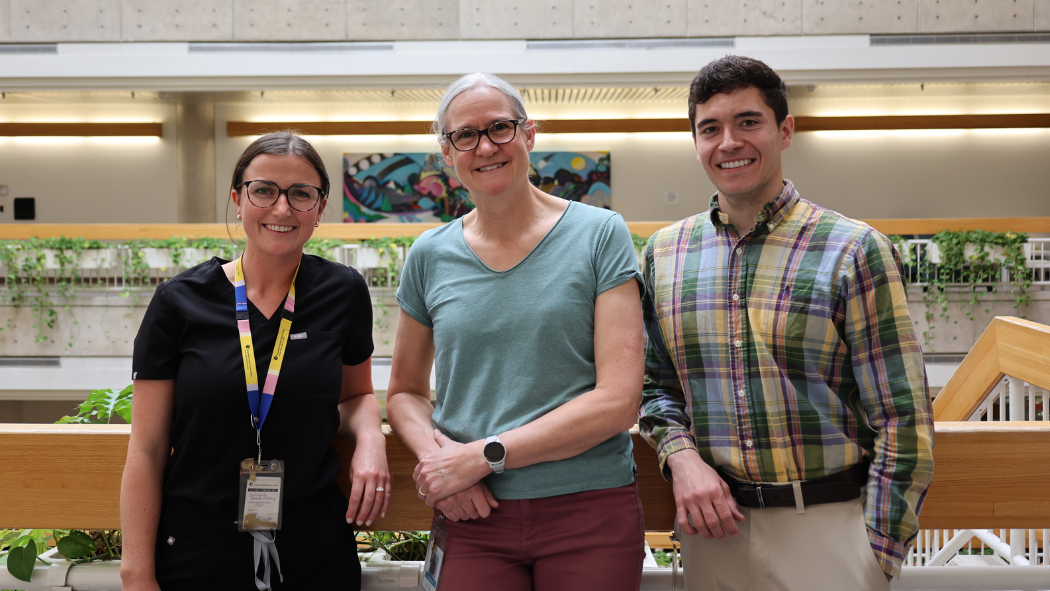
From left: Jennifer Murray (Nurse Practitioner, Cancer Care), Catherine Bond-Mills (Pharmacist, Pharmacy – Oncology and Renal), and Spencer Martin (Manager, Pharmacy – Oncology and Renal) in the Verspeeten Family Cancer Centre
May 30, 2025
Smoking Treatment for Ontario Patients, or STOP, is a smoking cessation program from the Centre for Addiction and Mental Health (CAMH) which is implemented at various healthcare organizations across Ontario.
As of May, this program is now available for patients with a head and neck cancer diagnosis at London Health Sciences Centre (LHSC). Head and neck cancer diagnoses include the mouth, throat and voice box, but do not include brain, esophageal or lung cancers.
The STOP program is available for head and neck cancer patients because it is important, even after a cancer diagnosis, to quit smoking.
“Smoking cessation improves outcomes and should be a high-priority intervention. We know it can take numerous attempts at quitting before patients can break the habit, and we also know that nicotine replacement therapy can double the chances of someone quitting successfully. Follow-up is critical in supporting patients in their goals given the chronic and relapsing patterns of tobacco addiction. With the STOP program, patients can now be connected to counselling surrounding their nicotine use and access nicotine replacement products,” explains Jennifer Murray, Nurse Practitioner, Cancer Care at LHSC.
STOP program at LHSC
As the Nurse Practitioner for the Head and Neck Cancer team, Murray supports patients undergoing treatment at LHSC’s Verspeeten Family Cancer Centre. As part of her role in STOP, she will identify patients who use tobacco/commercial cigarettes and who are interested in quitting smoking. She will also work with team members such as the medical oncologists and the Head and Neck patient navigator, to identify patients who may benefit from the program who she has not yet met so they can start the referral process.
The program consists of nicotine replacement therapy (NRT), such as patches, gum, lozenges and inhalers, as well as personalized counselling. Patients receive up to 26 weeks of nicotine replacement therapy and counselling support free of charge. At every four-week interval, the patient comes back to the Verspeeten Family Cancer Centre Pharmacy to check-in on their progress and receive counselling and NRT as appropriate.
Once the patient’s NRT preferences are identified, the Verspeeten Family Cancer Centre Pharmacy receives NRT and follows up with patients.
Spencer Martin, Interim Manager, Pharmacy – Oncology and Renal, LHSC, assists with training staff, coordinating with healthcare partners and ensuring the program runs smoothly to support patients.
“Pharmacists play a critical role by offering personalized smoking cessation counselling, assessing patient readiness to quit and helping develop tailored plans to quit,” Martin says. “We provide access to NRT at no cost through the STOP program and our goal is to be a consistent and accessible support throughout the patient’s smoking cessation journey.”
There is a questionnaire that patients are asked that helps to understand their nicotine use, identify stress and anxiety levels, lifestyle, sleep and eating patterns to help understand lifestyle and encourage any changes that may help them quit smoking long-term. The questionnaire is followed up and used as a checkpoint for the health and well-being of the person trying to quit smoking.
While pharmacists already support patients through oncology medication counseling, they now are able to support head and neck cancer patients in smoking cessation.
“The STOP program allows us to take a more proactive role in a patient’s smoking cessation journey – a critical, but often under addressed aspect of patient care in cancer populations,” Martin says.
The teams involved in supporting this program all receive training from CAMH that covers the principles of smoking cessation such as behaviour modification, lifestyle changes and the challenges those trying to quit smoking commercial cigarettes face.
“We try to encourage quitting while acknowledging how hard it is and do our best to support patients along the way. It’s a realistic approach to smoking cessation,” Murray says. “It has been shown that smoking cessation during treatment for head and neck cancers decreases treatment-related toxicities and the risk of disease progression. The STOP program has the potential to help more patients achieve smoking cessation goals leading to improved disease outcomes and decreased toxicities, which may lead to improved cancer treatment experiences.”
Martin shares, “Head and neck cancer patients often face heightened urgency to quit. The STOP program bridges the gap by offering free, pharmacist-led smoking cessation services.”
Criteria for the program
To be eligible to participate in the STOP program, as outlined on the CAMH website, a patient with a head and neck cancer diagnosis must:
- Currently using tobacco/nicotine product(s) or has recently quit (within the last 30 days)
- Live within Ontario
Other smoking cessation resources
If you are someone who fits the criteria above and would like to quit smoking but are not a patient at LHSC with a head and neck cancer diagnosis:
- CAMH offers STOP on the Net, an online program to help quit smoking commercial cigarettes. More information about the STOP program and STOP on the Net is found on the CAMH website.
- Health 811 – A free, secure and confidential service Ontarians can call for non-urgent health questions and concerns, including quit counselling.
- A list of other smoking cessation resources is found on the Don’t Quit Quitting – Across Ontario website.
